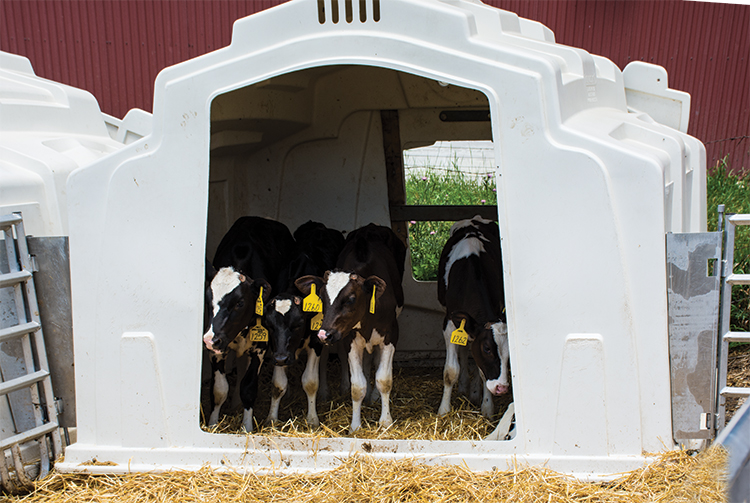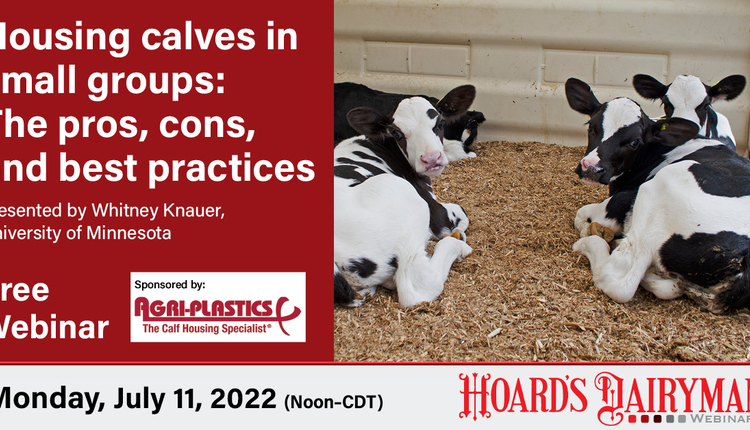The author is an assistant professor in the department of veterinary population medicine at the University of Minnesota.

Weaning is the most important transition a calf has to go through before she enters the milking herd, and it is a nutritionally and socially stressful time. Not only do calves have to adjust their digestive tract to accommodate a solid diet, but those that are individually housed (87 percent of calves in the U.S.) have to learn how to function as a herd animal for the first time.
Maintenance of health is another challenge. Calves are still reliant on immune protection from their dams at weaning, and don’t build a fully competent immune system until 5 to 8 months of age.
To help our calves become healthy and productive members of the milking herd, there are some areas we can focus on during the weaning process to ensure a smooth transition. This article will address four questions that producers often have that are relevant to the weaning and immediate postweaning period.
Step by step weaning
First, how long should the period be?
This period is important as careful management of the “step down” — the amount of time it takes until milk is fully removed from the diet — can reduce or eliminate a postweaning slump in growth, which is usually due to a lag in starter intake. The step down can be gradual over a period of days to weeks or abrupt.
Most of the current research supports a gradual step down, especially when feeding larger quantities of milk. One recent study reported improved starter intake and growth immediately postweaning when comparing an abrupt weaning (removing milk on day 48) to weaning over a period of 12 days (50 percent reduction in milk from day 36 to 48).
Best practices for the step down period include reducing the amount of milk offered by 50 percent, offered once per day. Offer fresh starter and water at the opposite time of day to encourage starter consumption when calves are active and expecting milk, with complete weaning occurring 10 to 14 days later.
Two is better than one
Next, do calves do better with a buddy?
An emerging body of research from the University of British Columbia is finding that there are real social and cognitive benefits to housing preweaned calves in a group of two as compared to housing them individually.
How can this help us at weaning?
Whether through group learning or competition, calves that are paired early in life (at 6 days of age) have been shown to eat more calf starter and have improved growth not only at weaning, but throughout the entire preweaning period when compared to individually housed calves.
Vocalization at weaning is often a sign of distress or discontent, typically peaking in the days after total cessation of milk. Paired calves have also been shown to vocalize less at weaning when compared to individually housed calves, suggesting that having another calf in close proximity allows them to cope better with challenging situations.
Though benefits exist, pair housing has some challenges. Calves still require the same amount of space (The Dairy Calf and Heifer Association recommends 36 square feet per calf), so not all housing systems will be able to accommodate an easy switch. We also have more to learn about the health effects of housing calves in a pair as compared to individually.
Wait to move
Third, how long should calves be kept in the hutch postweaning?
On most dairies this duration is driven by calving pressure and available space whether that be available calf hutches or space in a group pen.
There is certainly value to keeping calves in the hutch for a week or two postweaning prior to moving them to a larger group. This practice allows the calf easy access to grain and water and separates the nutritional stress of weaning from the social stress of grouping.
The research in this area is not conclusive, though. Some studies suggest that immediate grouping is equivalent or advantageous as compared to individual housing. Perhaps more important to the calf is ensuring that its environment, whether in a group or in individual housing, is clean, comfortable, adequately drained, well ventilated, and that grain and water are readily available and easily accessible.
A potential concern with immediate grouping is the risk of cross suckling. This could lead to consequences downstream such as blind quarters and heifer mastitis.
Give them space
Finally, what is the best way to group calves out of the hutch or pair?
Place calves into small groups (six to eight calves per group) initially with a minimum of 30 square feet of pack or bedded space per calf. Starter and water should be readily available with a minimum of 18 inches of feeding space per calf. Some calves are wary of placing their head through a head gate, so it is advisable to initially place calf starter within the pen to accommodate timid calves.
The age range within the weaned group should be no more than one month, and preferably no more than two weeks. This is to prevent older calves from bullying younger, smaller ones, as well as to prevent disease transmission. Throughout the heifer growth phase, it’s important to reduce the number of regroupings and to move groups of heifers together. Each time a new group is formed, there is social upheaval and an elevation in stress, with potential immune suppression and disease. If heifers are allowed to move with other heifers they know, they will be less stressed and the group will be more socially harmonious.
Weaning is a stressful time for a calf, but if the transition is managed carefully producers can benefit from healthy, well-grown heifers.
Best weaning period practices:
- Reducing the amount of milk offered gradually over a period of one to two weeks can encourage starter intake and reduce the postweaning growth slump.
- There are social and performance benefits to housing calves in pairs throughout the preweaning period.
- Keeping calves in the hutch or pair for a week or two after the removal of milk can help with grain intake, but immediate grouping can also work if calves have adequate space that is clean and comfortable with grain and water readily available.
- Postweaned groups of six to eight head and minimal regrouping can help get heifers off to a good start.









